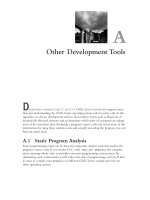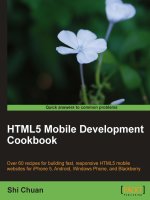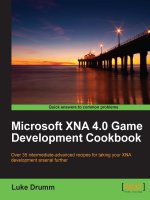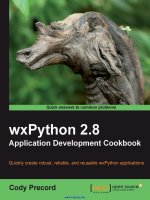Azure lot development cookbook pdf
Bạn đang xem bản rút gọn của tài liệu. Xem và tải ngay bản đầy đủ của tài liệu tại đây (12.17 MB, 364 trang )
Azure IoT Development Cookbook
Develop and manage robust IoT solutions
Yatish Patil
BIRMINGHAM - MUMBAI
< html PUBLIC "-//W3C//DTD HTML 4.0 Transitional//EN"
" />
Azure IoT Development Cookbook
Copyright © 2017 Packt Publishing
All rights reserved. No part of this book may be reproduced, stored in a
retrieval system, or transmitted in any form or by any means, without the
prior written permission of the publisher, except in the case of brief
quotations embedded in critical articles or reviews.
Every effort has been made in the preparation of this book to ensure the
accuracy of the information presented. However, the information contained in
this book is sold without warranty, either express or implied. Neither the
author, nor Packt Publishing, and its dealers and distributors will be held
liable for any damages caused or alleged to be caused directly or indirectly by
this book.
Packt Publishing has endeavored to provide trademark information about all
of the companies and products mentioned in this book by the appropriate use
of capitals. However, Packt Publishing cannot guarantee the accuracy of this
information.
First published: August 2017
Production reference: 1100817
Published by Packt Publishing Ltd.
Livery Place
35 Livery Street
Birmingham
B3 2PB, UK.
ISBN 978-1-78728-300-8
www.packtpub.com
Credits
Author
Copy Editor
Yatish Patil
Juliana Nair
Reviewers
Project Coordinator
Ruben Oliva Ramos
Judie Jose
Roberto Freato
Acquisition Editor
Proofreader
Heramb Bhavsar
Safis Editing
Content Development Editor
Indexer
Devika Battike
Aishwarya Gangawane
Technical Editor
Graphics
Prachi Sawant
Kirk D'Penha
Production Coordinator
Aparna Bhagat
About the Author
Yatish Patil is currently working with Saviant Consulting as a technical
project manager. He has delivered enterprise IoT and analytics applications
using Microsoft Azure, ASP.NET, MVC, C#, SQL Server, and NoSQL. He
has diverse industrial experience in IT and has worked in a variety of
domains, such as utilities, manufacturing, and engineering.
He has completed his certification in Developing Azure Solutions in the
Microsoft Azure Certification.
Yatish was also the technical reviewer for a Microsoft Azure-based
technology book Microsoft Azure IaaS Essentials, which teaches guides
Microsoft Azure subscribers how to design, configure, and build cloud-based
infrastructure using Microsoft Azure.
Yatish was among the industry speakers at India IoT Symposium, 2016. He
delivered the industry session on remote asset monitoring with Microsoft
Azure IoT Suite.
I would like to thank my father, mother, and brother for always being
supportive and letting me do what I want; my wife, Vasudha, and my son,
Rudra, for tolerating the many late nights it took to write this book.
I would like to thank my mentors, who have been instrumental in my career Anubhav Dwivedi, CEO Saviant, and Sujit Karpe, CTO Saviant, for being
wonderful teachers, bosses, leaders, and friends, for providing me
opportunities and encouraging me, and making me a proud member of Team
Saviant, a workplace for inspiration, continuous innovation, and growth.
Last but not least, I thank the entire team at Packt, especially Heramb
Bhavsar, Devika Battike, Prachi Sawant, and the reviewers, for their
patience, suggestions, and support throughout this project and making this a
memorable project for me.
About the Reviewers
Roberto Freato has been an independent IT consultant since he started to
work. Working for small software factories while he was studying, after his
MSc in computer science engineering with a thesis about consumer cloud
computing he got specialization in Cloud and Azure. Today he works as a
freelance consultant for major companies in Italy, helping clients to design
and kick-off their distributed software solutions. He trains for the developer
community in the free time, speaking in many conferences. He is a Microsoft
MVP since 2010.
Ruben Oliva Ramos is a computer systems engineer from Tecnologico of
Leon Institute, with a master's degree in computer and electronic systems
engineering, teleinformatics and networking specialization from University of
Salle Bajio in Leon, Guanajuato Mexico. He has more than 5 years of
experience in developing WEB applications to control and monitor devices
connected with Arduino and Raspberry Pi using WEB Frameworks and
Cloud Services to build the Internet of Things applications.
He is a mechatronics teacher at University of Salle Bajio and teaches students
on the master's degree in design and engineering of mechatronics systems. He
also works at Centro de Bachillerato Tecnologico Industrial 225 in Leon,
Guanajuato Mexico, teaching subjects such as electronics, robotics and
control, automation and microcontrollers at mechatronics technician career,
consultant, and developer projects in areas such as monitoring systems and
datalogger data using technologies such as Android, iOS, Windows Phone,
HTML5, PHP, CSS, Ajax, JavaScript, Angular, and ASP .NET; databases
such as SQlite, mongoDB, and MySQL; Web servers such as Node.js and
IIS; and hardware programming such as Arduino, Raspberry pi, Ethernet
Shield, GPS and GSM/GPRS, ESP8266, and control and monitor systems for
Data Acquisition and Programming.
I would like to thank my savior and lord, Jesus Christ for giving me strength
and courage to pursue this project, to my dearest wife, Mayte, our two lovely
sons, Ruben and Dario, To my father (Ruben), my dearest mom (Rosalia), my
brother (Juan Tomas), and my sister (Rosalia) whom I love, for all their
support while reviewing this book, for allowing me to pursue my dream and
tolerating not being with them after my busy day job.
www.PacktPub.com
For support files and downloads related to your book, please visit www.PacktPub
.com.
Did you know that Packt offers eBook versions of every book published, with
PDF and ePub files available? You can upgrade to the eBook version at www.P
acktPub.com and as a print book customer, you are entitled to a discount on the
eBook copy. Get in touch with us at for more details.
At www.PacktPub.com, you can also read a collection of free technical articles,
sign up for a range of free newsletters and receive exclusive discounts and
offers on Packt books and eBooks.
/>
Get the most in-demand software skills with Mapt. Mapt gives you full
access to all Packt books and video courses, as well as industry-leading tools
to help you plan your personal development and advance your career.
Why subscribe?
Fully searchable across every book published by Packt
Copy and paste, print, and bookmark content
On demand and accessible via a web browser
Customer Feedback
Thanks for purchasing this Packt book. At Packt, quality is at the heart of our
editorial process. To help us improve, please leave us an honest review on
this book's Amazon page at />If you'd like to join our team of regular reviewers, you can e-mail us at
We award our regular reviewers with free eBooks
and videos in exchange for their valuable feedback. Help us be relentless in
improving our products!
Table of Contents
Preface
What this book covers
What you need for this book
Who this book is for
Sections
Getting ready
How to do it…
How it works…
There's more…
See also
Conventions
Reader feedback
Customer support
Downloading the example code
Downloading the color images of this book
Errata
Piracy
Questions
1.
Getting Started with the Azure IoT Platform
Introduction
Getting started with the Microsoft Azure IoT platform
Components of the IoT platform
Microsoft Azure IoT platform
Creating Azure IoT Hub from the portal
Getting ready
How to do it...
Creating Azure IoT Hub from the Command Prompt
How to do it...
Creating Azure IoT Hub from PowerShell
How to do it...
Understanding the Azure IoT Suite
How to do it...
How it works...
Pre-configured solutions
Using Azure IoT SDK
Getting ready
How to do it...
See also
Calculating the pricing of IoT Hub
Getting ready
How to do it...
There's more...
See also
2.
Introducing Device Management
Introduction
Understanding IoT Hub endpoints
Device registry operations
Getting ready
How to do it...
How it works...
There's more...
Device twins
How to do it...
How it works...
There's more...
Device direct methods
How to do it...
How it works...
Device jobs
How to do it...
How it works...
There's more...
IoT Hub query explorer
How to do it...
There's more...
3.
IoT Hub Messaging and Commands
Introduction
Messaging - device-to-cloud
How to do it...
How it works...
There's more...
See also
Processing device-to-cloud messaging
How to do it...
How it works...
There's more...
Messaging - commands and control
How to do it...
How it works...
File uploads with IoT Hub
Getting ready
How to do it...
How it works...
There's more...
Device firmware updates
How to do it...
How it works...
4.
Azure IoT Communication Protocols
Introduction
Hyper Text Transfer Protocol Secure (HTTPS)
How to do it...
How it works...
Advanced Message Queuing Protocol (AMQP)
How to do it...
How it works...
Using AMQP library to communicate with IoT Hub
Getting ready
How to do it...
How it works...
Message Queuing Telemetry Transport Protocol (MQTT)
Getting started
How to do it...
How it works...
There's more...
IoT protocol gateway
Getting started
How to do it...
How it works...
There's more...
Using MQTT .NET library to communicate with IoT Hub
Getting ready
How to do it...
How it works...
There's more...
Connecting IoT Hub using MQTT client tools
Getting ready
How to do it...
How it works...
How to choose between protocols
Getting ready
How do it...
How it works...
5.
Azure IoT Hub Security and Best Practices
Introduction
Securing a device with IoT Hub
Getting ready
How to do it...
How it works...
There's more...
Securing a communication
Getting ready
How to do it...
There's more...
IP filtering with IoT Hub
Getting ready
How to do it...
How it works...
There's more...
IoT Hub access rights
Getting ready
How to do it...
How it works...
Security best practices
How to do it...
There's more...
6.
IoT Suite and Pre-Configured Solutions
Introduction
Creating a Pre-configured solution
Getting ready
How to do it...
How it works...
IoT Suite remote monitoring
Getting ready
How to do it...
How it works...
There's more...
See also
IoT Suite predictive maintenance
Getting ready
How to do it...
How it works...
There's more...
See also
IoT Suite connected factory
Getting ready
How to do it...
How it works...
Customizing an IoT Suite
How to do it...
How it works...
There's more
7.
Azure IoT Analytics
Introduction
Understanding the Azure IoT lifecycle
IoT solution lifecycle
Components of the IoT solution lifecycle
Connecting IoT Hub with Stream Analytics
Getting ready
How to do it...
Real-time dashboard reports for IoT data using Power BI
Getting ready
How to do it...
There's more...
Azure Time Series Insights
Getting ready
How to do it...
IoT Edge analytics using a simulator
Getting ready
How to do it...
Real-time alerts with Azure functions
How to do it...
There's more...
8.
Using Real Devices to Connect and Implement Azure IoT Hub
Install Windows IoT Core on Raspberry Pi
Getting ready
How to do it...
There's more...
Connect and configure IoT Core on Raspberry Pi
Getting ready
How to do it...
There's more...
Demo - smart parking
Getting ready
How to do it...
How it works...
Demo - temperature and humidity
Getting ready
How to do it...
How it works...
Using an online Raspberry Pi simulator
How to do it...
9.
Managing the Azure IoT Hub
Introduction
Device explorer for the Azure IoT Hub
Getting ready
How to do it...
Using the IoT Hub command-line tool
How to do it...
There's more...
IoT Hub operation monitoring
Getting ready
How to do it...
There's more...
See also
The diagnostic metrics of the Azure IoT Hub
How to do it...
Scaling your IoT Hub solution
Getting ready
How to do it...
There's more...
Preface
The Microsoft Azure Internet of Things (IoT) platform is a set of IoT
capabilities enabling businesses to build and gain value from IoT solutions
quickly and efficiently. As part of their IoT Suite, Microsoft Azure IoT
services enable the customers in their IoT journey - whether they are on their
journey or looking to scale their IoT solutions, transforming their digital
business.
Today, developers are leveraging the power of IoT in building IoT solutions
for enterprises by getting started quickly with help from Azure IoT services a set of open source SDKs, samples, pre-configured solutions, and tools
provided by Microsoft Azure.
Azure IoT Hub is an easy and secure way to connect, provision, and manage
millions of IoT devices, which are continuously sending and receiving
billions of messages per specified or configurable interval. IoT Hub helps the
communication between IoT devices and their solutions in the cloud,
allowing them to store, analyze, alert, and take action on that data in real
time. IoT Hub provides secure, reliable, two-way communication - both
device-to-cloud and cloud-to-device - over open protocols such as MQTT,
HTTPS, and AMQPS that are commonly used in IoT scenarios.
The aim of this book is to help the developer who wants to connect devices to
IoT Hub, manage the IoT Hub service itself, and integrate IoT Hub into their
overall IoT solution in the cloud. It discusses how to implement secure IoT
solution, and implement IoT analytics scenarios. It also dives into preconfigured solutions, followed by some real device connectivity to explore
the capabilities of IoT Hub.
What this book covers
Getting Started with the Azure IoT Platform, introduces the
Microsoft Azure IoT platform, which provides device management
capabilities, as well as secure and bidirectional communication between
millions of devices. Azure IoT Hub is the key for building IoT solutions. The
chapter will focus on the different ways to create an IoT Hub service to
connect devices. It will also dive more into the Azure IoT SDK and how the
pricing works for Azure IoT Hub.
Chapter 1,
Introducing Device Management, explains that a crucial part of IoT
is to manage the device. Azure IoT Hub provides standard device
management capabilities. With this feature synchronization between devices,
updating metadata and executing actions are easy to implement for a
developer. This chapter's focus will be to explain how to do device
management with Azure IoT Hub, device communication operation, update
device metadata, and execute commands.
Chapter 2,
IoT Hub Messaging and Commands, describes the secure messaging
between the connected device and IoT Hub. The chapter shows how to send
an IoT device-to-cloud messages and receive cloud-to-device messages. It
also shows how to ingest the file by uploading it to storage and updating
device firmware remotely.
Chapter 3,
Azure IoT Communication Protocols, focuses on the way IoT
devices communicates with the cloud using various protocols. We will look
at different recipes that show the different communication protocols IoT Hub
supports and how we can connect these IoT devices to IoT Hub.
Chapter 4,
Azure IoT Hub Security and Best Practices, dives more into IoT Hub
concept such as securing and following best security practices. This chapter
covers the different security standard supported by IoT Hub and how your
IoT solution can make use of them to build a secure platform for connected
devices.
Chapter 5,
IoT Suite and Pre-Configured Solutions, discusses building common
IoT scenarios quickly and going live with these solutions. Microsoft Azure
IoT Suite is IoT Hub with a combination of commonly used cloud services
such as storage, stream analytics, and visualizations using Power BI. It
provides an example for each plugin by highlighting the requirements for
each setup.
Chapter 6,
Azure IoT Analytics, discusses the Azure services, which in
conjunction with IoT Hub help businesses to drive their objectives. With
connected devices, some significant challenges are seen with the diverse data
volume and variety. This chapter covers the different Azure analytics
services, that works with IoT Hub and help businesses to achieve their
outcomes.
Chapter 7,
Using Real Devices to Connect and Implement Azure IoT Hub,
discusses how to configure and connect a real device with IoT Hub. This
chapter covers a real-world case study and shows how it can be solved with
IoT. We will discusses about reference IoT architecture, which can be built
on top of the Azure platform. It also covers also connecting a Raspberry Pi
device to implement a solution such as smart parking.
Chapter 8,
Managing the Azure IoT Hub, dives more into the ways to manage
the IoT Hub service with different tools and techniques. It starts with using
the device explorer to manage the capabilities of IoT Hub, and moves onto
getting diagnostic information using the Azure portal for the operational logs
and metrics, which provides detailed logging of connected devices, and
shows how to find solutions using debugging tools and hands-on tips.
Chapter 9,









